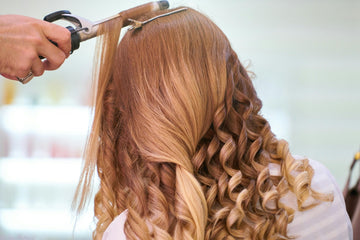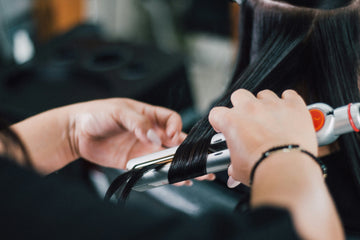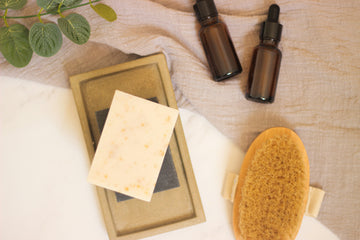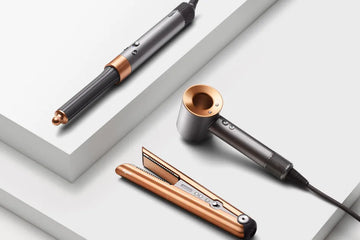We’re breaking down everything—heat control, styling results, and price—so you can stop guessing and start glowing.
In the world of hot tools, few comparisons spark more debate than Dyson Airwrap vs curling iron. The Airwrap’s futuristic tech, airflow-driven curling, and gentle heat control make it a dream tool for some. Meanwhile, curling irons remain a reliable staple—offering tension, speed, and defined curls that many stylists still swear by.
By the end of this guide, you’ll understand which tool fits your hair type, preferred styles, and routine demands. Plus, I’ll share key factors to consider (like heat damage, ease of use, and versatility) so you can shop smarter, not harder.
Dyson Airwrap: How it works + what makes it unique
If you’ve spent any time on social media or browsing beauty shelves, you’ve probably seen the Dyson Airwrap pop up as the ultimate styling flex. With its futuristic design, multi-styler attachments, and sky-high price tag, this tool has become the gold standard for heatless styling—but does it actually live up to the hype? Here’s a closer look at how it works, why it’s different from a curling iron, and who it’s really best for.
Air-powered curling, not high heat
The Dyson Airwrap Multi‑Styler changes the way hair is curled, waved, and smoothed by using air—not just heat. It relies on the Coandă effect, where a high-velocity jet of air wraps hair around the barrel without needing to clamp or twist. This airflow method helps reduce extreme heat exposure, which is a game changer for protecting hair health over time.
Intelligent heat regulation
Instead of blasting your strands with high temps, the Airwrap features intelligent heat control that checks the temperature more than 40 times per second. This keeps the tool below ~302°F at all times. The benefit? You get styling power without the same risk of heat damage, making it ideal for color-treated, fine, or fragile hair types.
One tool, many attachments
Another standout feature is its versatility. The Airwrap comes with multiple attachments:
-
Barrels in two sizes (1.2" and 1.6") to create loose waves or tighter curls
-
Firm and soft brushes to smooth or add body
- A pre-styling dryer to rough-dry hair before you style
This makes it a true multi-styler that’s ideal for someone who likes to switch up their look often—or prefers a blowout-style finish without reaching for a round brush and dryer.
Gentler on ends
Because there’s no clamping involved, the Airwrap is especially gentle on the ends of your hair. That means fewer creases, less mechanical stress, and a smoother overall finish. The airflow styling mimics a salon-quality blowout more than a typical curl.
Learning curve to master
While the concept is innovative, it’s not always intuitive at first. Using airflow to wrap hair feels very different from manually wrapping sections around a hot barrel. You’ll need to experiment a bit with direction, tension, and sectioning to find your rhythm. But once you do, it’s a fast and effective way to style without overheating your strands.
Is it right for your hair?
The Airwrap works best for those who value multi-functionality and lower heat exposure. It’s great for fine to medium hair, and for anyone who wants a softer, blown-out look. However, those with coarse or resistant textures might find they need additional hold products or touch-ups to keep curls intact all day.
Pros & cons of the Dyson Airwrap
Pros:
-
Gentler on hair due to lower effective heat
-
Multipurpose tool (curling, smoothing, drying)
-
No clamp marks
-
Intelligent heat regulation
Cons:
-
Steeper cost
-
Learning curve in technique
-
May not deliver tight curls as easily on coarse or resistant hair
- Battery or cord length limitations depending on model
Curling irons: tried-and-true performance
When it comes to creating defined, long-lasting curls, the traditional curling iron still holds its ground. While newer tools may promise innovation, curling irons remain a staple in styling arsenals thanks to their direct heat, reliable tension, and no-nonsense results.
How curling irons work
Curling irons use a heated barrel and clamp (or wand-style tension) to physically reshape the hair strand. By wrapping hair around the hot barrel and holding it in place for a few seconds, you’re essentially reforming the hydrogen bonds within the hair’s cortex. Once cooled, the shape sets—giving you those classic curls, waves, or bends.
Because of the direct contact with heat and the ability to apply manual tension, curling irons tend to produce more defined, structured curls compared to airflow-based stylers. For hair types that resist curl—like coarse, straight, or stubborn strands—that level of precision can be the difference between loose bends that fall flat and photo-ready hold that lasts all day.
High heat = high hold (with caution)
Many curling irons can heat up to 400–425°F or more, and they tend to reach those temps faster than airflow stylers. That makes them ideal for those who don’t want to spend too long holding each section or waiting for the tool to heat up.
However, that same heat is a double-edged sword. Without a heat protectant or temperature control, repeated use on high heat can lead to dryness, frizz, or long-term cuticle damage—especially for color-treated or fine hair. The key is balance: using the right temp for your hair type (lower for fine or damaged, higher for thick or coarse) and always prepping with a protectant like TYME's Moisture Hydrate & Heat Protectant Spray.
Customization for every curl
Another reason curling irons have stuck around? They're incredibly versatile. Between the different barrel sizes, clamp styles, and materials (like ceramic, titanium, and tourmaline), there’s an option for nearly every hair type and curl preference.
-
Smaller barrels (¾” to 1”): Great for tighter ringlets or classic curls that hold up over time.
-
Larger barrels (1.25” to 2”): Perfect for beachy waves or voluminous, soft curls.
-
Tapered barrels: Allow you to control the width of the curl—tight at the root, looser at the end.
- Clamp vs wand: Clamps give polished curls with smooth, even tension. Wands offer a looser, more tousled look without creases.
You also don’t need to buy multiple tools to get different effects. A single wand can give you casual waves, voluminous bends, or even retro glam curls—just change the section size, direction, or how long you hold the hair in place.
A beginner-friendly favorite
Unlike stylers that require mastering airflow direction or swapping attachments, curling irons are intuitive. Clip the hair, twist, hold, release. Their ease of use makes them an approachable choice for beginners and busy mornings alike.
That said, good technique can still elevate your results. Holding the iron vertically vs horizontally, curling away from the face vs toward it, or alternating directions all make a visible difference in your final look. Add in a cool-shot or setting spray, and your curls are locked in for the long haul.
Who it works best for
If you’ve got medium to thick hair and want curls that last more than a few hours, curling irons are a top-tier pick. They’re especially reliable for:
-
Coarse or straight hair that struggles to hold curl
-
Special occasions that call for long-lasting definition
-
Fast styling with minimal fuss
- Versatile everyday waves with a polished finish
And with today’s modern irons offering digital temperature control, dual voltage for travel, and sleek ergonomic designs, it’s never been easier to get salon-worthy curls from home.
Pros & cons of curling irons
Pros:
-
Strong curl retention
-
Fast heating and consistent temperature
-
Familiar technique for many users
- Usually lower price points for comparable barrels
Cons:
-
Direct heat can lead to damage if misused
-
Clamp lines or creases if not handled carefully
-
Can be less forgiving with mistakes
- Requires full dryness before use (no wet-to-dry in most cases)

Side-by-side comparison: What to weigh in your decision
|
Feature |
Dyson Airwrap |
Curling Iron |
|---|---|---|
|
Heat exposure |
Low to moderate; controlled via airflow |
High; direct plate/ceramic contact |
|
Learning curve |
Medium to high |
Low to medium |
|
Curl hold |
Fair to good (on many hair types) |
Good to excellent (especially on resistant hair) |
|
Versatility |
High (curls, smooths, brush attachments) |
Medium (primarily curling) |
|
Ideal hair types |
Fine to medium, fragile or lightly processed hair |
Thick, coarse, resistant strands |
|
Price & accessibility |
Premium |
Wide price range |
|
Risk of clamp lines |
Low |
Moderate to high |
Your hair texture, daily styling habits, and appetite for learning probably decide the winner more than any spec on paper.
How to choose: What’s best for you
1. Hair type & texture
If your hair is fine, brittle, color-treated, or prone to breakage, the gentler heat of an Airwrap might safeguard your strands better. For thick or coarse hair, a high-heat curling iron may deliver curls that hold longer.
2. Style goals
Want one tool that can do it all—curls, waves, smoothing? Airwrap’s attachments offer that versatility. Want direct, deep-set ringlets or tighter curls? A high-quality curling iron gives you more control over tension and shape.
3. Convenience vs. commitment
If you travel often, want to minimize damage, or prefer styling tools that multitask, the Airwrap shines. But if you value fast results, consistent curls, and lower tool costs, a curling iron might be more practical.
4. Learning curve & patience
The Airwrap’s airflow method takes adjustment. Some stylists and users note it can be frustrating at first until you master the trajectory and hold. Curling irons tend to be more intuitive—clamp, twist, release.
Tips to protect your hair with either tool
Whether you prefer the high-tech airflow of the Dyson or the classic heat of a curling iron, heat styling always requires a little extra care. The goal? Beautiful, long-lasting curls without sacrificing the health of your hair in the process. Here’s how to build a protective styling routine, no matter which tool you’re using:
Start with a quality heat protectant.
This is non-negotiable. A lightweight spray like the Lauren Ashtyn Moisture Hydrate Spray acts as a barrier between your hair and heat, helping to lock in moisture and reduce the risk of split ends or dryness. Make sure to apply it evenly from mid-lengths to ends before styling.
Use the lowest effective heat setting.
Higher heat doesn’t always mean better results—it just means more risk. Choose the lowest temperature that still shapes your strands. Fine or damaged hair typically needs less heat than coarse or resistant textures.
Work in small, manageable sections.
Smaller sections allow for better control, more even heat distribution, and less need to re-style the same piece multiple times. This helps prevent overexposure in any one spot.
Avoid repeat passes.
Resist the urge to re-curl a section over and over. If a curl didn’t take, let it cool completely before going over it again. Repeated passes on hot hair can quickly lead to damage.
Set your curls for longevity.
Let each curl cool in place before brushing or touching. You can even clip each curl up to cool in a coiled shape to lock in definition and bounce.
Use cool air strategically.
If your tool has a cool-shot function (like the Dyson Airwrap), use it to “set” the curl in place. The shift from hot to cool helps the hair structure hold its shape.
Make time for repair.
Add deep conditioning into your weekly routine—1 to 2 times a week is a good cadence, especially if you heat style often. Opt for masks that restore moisture and strengthen the hair’s cuticle. Once a month, use a clarifying shampoo to remove product buildup and keep your strands fresh and responsive to styling.
Bonus tip: Trim regularly.
Split ends are more vulnerable to heat and tend to worsen with frequent styling. Regular trims keep your hair healthier and help your curls look cleaner and more polished.
Airwrap or curling iron—which should you pick?
If you want one tool that’s gentle, tech-forward, and multifunctional—and you’re willing to learn its nuances—the Dyson Airwrap offers a modern, hair-kind alternative to traditional styling. For those who prize speed, curl longevity, and a more familiar technique, the curling iron remains a dependable workhorse.
There’s no one-size-fits-all winner. The best pick is the one that aligns with your hair, your goals, and your styling lifestyle.
Style confidently, protect consistently, and let your hair shine—whatever tool you choose.




